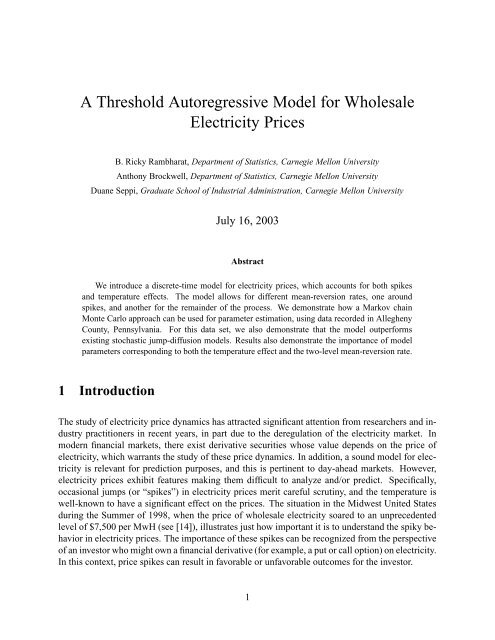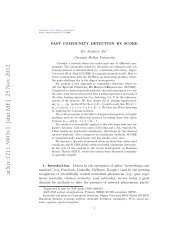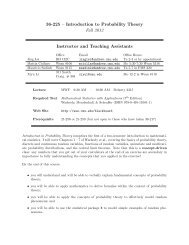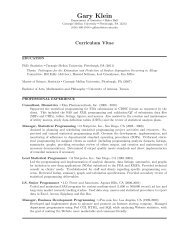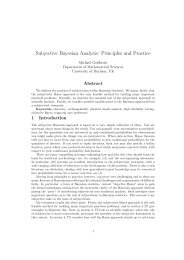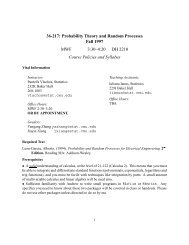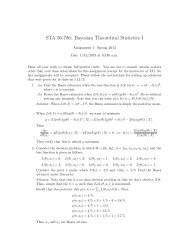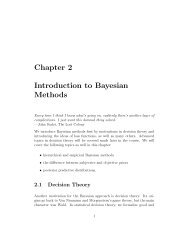A Threshold Autoregressive Model for Wholesale Electricity Prices
A Threshold Autoregressive Model for Wholesale Electricity Prices
A Threshold Autoregressive Model for Wholesale Electricity Prices
Create successful ePaper yourself
Turn your PDF publications into a flip-book with our unique Google optimized e-Paper software.
A <strong>Threshold</strong> <strong>Autoregressive</strong> <strong>Model</strong> <strong>for</strong> <strong>Wholesale</strong><br />
<strong>Electricity</strong> <strong>Prices</strong><br />
B. Ricky Rambharat, Department of Statistics, Carnegie Mellon University<br />
Anthony Brockwell, Department of Statistics, Carnegie Mellon University<br />
Duane Seppi, Graduate School of Industrial Administration, Carnegie Mellon University<br />
July 16, 2003<br />
Abstract<br />
We introduce a discrete-time model <strong>for</strong> electricity prices, which accounts <strong>for</strong> both spikes<br />
and temperature effects. The model allows <strong>for</strong> different mean-reversion rates, one around<br />
spikes, and another <strong>for</strong> the remainder of the process. We demonstrate how a Markov chain<br />
Monte Carlo approach can be used <strong>for</strong> parameter estimation, using data recorded in Allegheny<br />
County, Pennsylvania. For this data set, we also demonstrate that the model outper<strong>for</strong>ms<br />
existing stochastic jump-diffusion models. Results also demonstrate the importance of model<br />
parameters corresponding to both the temperature effect and the two-level mean-reversion rate.<br />
1 Introduction<br />
The study of electricity price dynamics has attracted significant attention from researchers and industry<br />
practitioners in recent years, in part due to the deregulation of the electricity market. In<br />
modern financial markets, there exist derivative securities whose value depends on the price of<br />
electricity, which warrants the study of these price dynamics. In addition, a sound model <strong>for</strong> electricity<br />
is relevant <strong>for</strong> prediction purposes, and this is pertinent to day-ahead markets. However,<br />
electricity prices exhibit features making them difficult to analyze and/or predict. Specifically,<br />
occasional jumps (or “spikes”) in electricity prices merit careful scrutiny, and the temperature is<br />
well-known to have a significant effect on the prices. The situation in the Midwest United States<br />
during the Summer of 1998, when the price of wholesale electricity soared to an unprecedented<br />
level of $7,500 per MwH (see [14]), illustrates just how important it is to understand the spiky behavior<br />
in electricity prices. The importance of these spikes can be recognized from the perspective<br />
of an investor who might own a financial derivative (<strong>for</strong> example, a put or call option) on electricity.<br />
In this context, price spikes can result in favorable or unfavorable outcomes <strong>for</strong> the investor.<br />
1
The extensive literature on the study of electricity prices includes varied attempts to capture the<br />
spiky behavior in electricity price series. Kellerhals [11] discusses some stochastic volatility models,<br />
but does not offer a specific treatment of the electricity spikes. Moreover, there exist stochastic<br />
jump-diffusion models such as the one set <strong>for</strong>th by Ethier and Dorris [8] (hence<strong>for</strong>th, the E&D<br />
model) that combine a mean-reverting component and a positive jump term modeled according to<br />
a Poisson process (see also [2]). However, this assumes that the rate of mean reversion is the same<br />
throughout the price series, regardless of whether spikes are present or not. Additionally, there<br />
exist models that separate the mean-reversion in electricity prices from the spikes (Huisman and<br />
Mahieu [10]) via a regime jump model. In this case, if the prices spike up to a “jump regime”, they<br />
must immediately return to the “mean-reversion regime.” However, there is no study of the rate<br />
of mean-reversion in the presence of spikes, and how that might differ when there are no spikes.<br />
Deng [7] details various stochastic models <strong>for</strong> electricity prices, which include the jump-diffusion<br />
and regime switching types mentioned above, and also a stochastic volatility model. There is also<br />
discussion on how these models are applicable in pricing derivative securities. However, procedures<br />
to estimate parameters in these models would not be straight<strong>for</strong>ward to implement.<br />
In this article, we propose a variant of a first-order threshold autoregressive model (TAR(1)) <strong>for</strong><br />
wholesale electricity prices. (For discussion of TAR models, see, e.g., Tong [16], or, <strong>for</strong> the<br />
continuous-time versions of these models, Stramer, Brockwell, and Tweedie [15].) In addition to<br />
accounting <strong>for</strong> spikes and allowing <strong>for</strong> a temperature-driven effect, the model allows the threshold<br />
to be time-varying. Effectively, it allows the mean-reversion parameter to change in the presence<br />
of spikes. (Alvaredo and Rajaraman [1] noted this phenomenon, but they did not make a specific<br />
proposal <strong>for</strong> modeling it. In fact, to the authors’ knowledge, the literature does not contain analyses<br />
focusing on how the rate of mean-reversion might depend on the price level.) We estimate model<br />
parameters using a Markov chain Monte Carlo (MCMC) procedure, and compare our model to the<br />
E&D model, showing that our model provides a better fit to wholesale electricity prices collected<br />
in Allegheny County, Pennsylvania over a three-year period.<br />
The paper is organized as follows. Section 2 describes the data set, and discusses several important<br />
features. In Section 3, we construct the model <strong>for</strong> the data, and describe the fitting procedure. A<br />
discussion of the fitted model is given in Section 4, while Section 5 gives concluding remarks.<br />
2 Description of Data<br />
2.1 The <strong>Wholesale</strong> <strong>Electricity</strong> Price Data<br />
We consider the maximum daily wholesale electricity prices in Allegheny County, Pennsylvania,<br />
collected over the three-year period from January 1999 to December 2001. The data were taken<br />
from www.pjm.com, a website that publishes wholesale electricity prices <strong>for</strong> regions in the Mid-<br />
Atlantic. We choose to use the maximum daily price in order to preserve the effects of the spikes<br />
in the price process (typically the spikes only last <strong>for</strong> a few hours). The maximum daily prices and<br />
their logs are shown, respectively, in Figures 1 and 2.<br />
2
1200<br />
Dollars per MwH<br />
1000<br />
800<br />
600<br />
400<br />
200<br />
0<br />
Wi99 Su99 Fa99 Wi00 Sp00 Su00 Fa00 Wi01 Sp01 Su01 Fa01<br />
Season of Year<br />
Figure 1: Maximum daily wholesale prices of electricity, from Jan 1999 to Dec 2001, <strong>for</strong> Allegheny<br />
County, PA.<br />
Figure 1 clearly illustrates the spikes, where the price jumps <strong>for</strong> a short period of time to values<br />
as high as per megawatt-hour. The portion of the price process without spikes is known to<br />
exhibit mean-reversion (see Kellerhals [11]). In order to avoid problems associated with modeling<br />
¢¡¤£¦¥§¥<br />
of highly-skewed distributions, in our analysis we work with the logarithm of the maximum daily<br />
prices. In Figure 2, we also include a non-parametric estimate of the mean of the log data.<br />
Figure 3 shows the sample partial autocorrelation function (PACF) of the logarithm of the maximum<br />
daily prices. This particular plot suggests that a low-order autoregressive model might<br />
be appropriate <strong>for</strong> the data, supporting the use of a lower-order autoregressive model such as<br />
a continuous-time AR(1) model (also referred to as an Ornstein-Uhlenbeck model or a Vasicek<br />
model, Vasicek [17]), a discrete-time version of such a model, or some variant of one of these.<br />
2.2 Temperature Data<br />
As a general rule, temperatures which deviate substantially from some “optimal value” are associated<br />
with high electricity prices. To investigate this phenomenon, we obtained temperature data <strong>for</strong><br />
Allegheny County, PA from the National Weather Services website (www.nws.noaa.gov), and<br />
extracted measurements corresponding to the times at which our electricity prices were recorded.<br />
These temperatures are plotted, <strong>for</strong> the time period from January 1999 to December 2001, in Figure<br />
4.<br />
3
8<br />
Log Dollars per MwH<br />
7<br />
6<br />
5<br />
4<br />
3<br />
2<br />
Wi99 Su99 Fa99 Wi00 Sp00 Su00 Fa00 Wi01 Sp01 Su01 Fa01<br />
Season of Year<br />
Figure 2: The logarithm of the maximum daily wholesale price of electricity, Jan 1999 to Dec<br />
2001, <strong>for</strong> Allegheny County, PA, along with a non-parametric estimate of the mean.<br />
4
Partial ACF<br />
0.0 0.2 0.4<br />
0 5 10 15 20 25 30<br />
Lag<br />
Figure 3: Sample partial autocorrelation function of the log of the maximum of daily electricity<br />
prices.<br />
5
Temperature (deg F)<br />
80<br />
60<br />
40<br />
20<br />
0<br />
Wi99 Su99 Fa99 Wi00 Sp00 Su00 Fa00 Wi01 Sp01 Su01 Fa01<br />
Season of Year<br />
Figure 4: Temperature data corresponding to price data over the period Jan 1999 - Dec 2001.<br />
Log of Daily Max <strong>Prices</strong> ($/MwH)<br />
3 4 5 6 7<br />
•<br />
• ••<br />
•<br />
•<br />
• •<br />
• • •<br />
• •<br />
• • • •<br />
•<br />
•<br />
• •<br />
• •<br />
• • •• ••<br />
• • ••<br />
••<br />
•<br />
••<br />
••<br />
• •• ••<br />
•<br />
•<br />
•<br />
• •<br />
•<br />
•<br />
•<br />
•<br />
••<br />
•<br />
•<br />
••<br />
••<br />
•• •<br />
•<br />
•<br />
• • • • •<br />
•<br />
• ••<br />
• •<br />
• •<br />
•<br />
••<br />
••<br />
•<br />
•<br />
•• • •<br />
•<br />
• ••<br />
• •<br />
•<br />
• •<br />
• •<br />
••<br />
• •<br />
• •<br />
• •<br />
•• •<br />
••<br />
••<br />
••<br />
••<br />
• •<br />
• •<br />
•<br />
•<br />
•<br />
•<br />
•<br />
•<br />
•<br />
•<br />
•<br />
•<br />
• • • •<br />
• • •<br />
• ••<br />
• •<br />
•<br />
• • •<br />
•<br />
•<br />
• •<br />
•<br />
•<br />
•<br />
• •<br />
•<br />
•• •<br />
•<br />
••<br />
•<br />
• •• •<br />
• •<br />
•<br />
• • •<br />
••<br />
•<br />
• •<br />
• • •<br />
•<br />
• • • • •<br />
0 20 40 60 80<br />
Temperature (deg F)<br />
Figure 5: Log maximum prices vs. corresponding temperature.<br />
6
¥<br />
£<br />
¡<br />
£<br />
¥<br />
I<br />
0<br />
<br />
The temperature time series exhibits a clear periodic component, with higher temperatures associated<br />
with summer months. In order to illustrate the relationship between temperatures and<br />
log-electricity prices, we give a scatter-plot of log-price versus temperature in Figure 5. The figure<br />
shows a parabolic relationship between the log of the maximum prices and temperature. We use<br />
the loess function in S-Plus (see [18]) in order to obtain a smooth fit to the plot (the smoothing<br />
parameter was chosen to be 2/3). This technique fits polynomials locally so that nearby data points<br />
are most influential in the fit (see Cleveland et al. [5] <strong>for</strong> details on LOESS). Using this method of<br />
smoothing, we find that the minimizing temperature is about 57.0 degrees Fahrenheit.<br />
In light of this, we assume that the log-daily maximum price ¢¡¤£¦¥ includes a component of the<br />
§©¨£<br />
<strong>for</strong>m , <strong>for</strong> some positive § constant , £ where denotes the temperature on the -th day,<br />
and represents the minimizing temperature. ¨¡¤£¡£ Hence should include a difference of<br />
this component, that is,<br />
§©¨%©£&' (¨£!'©£ *) (1)<br />
£$#<br />
§©¨£! <br />
"§©¨£ <br />
3 The Proposed <strong>Model</strong><br />
The sample PACF plot in Figure 3 suggests that a low-order autoregressive model might be appropriate<br />
<strong>for</strong> the data. We use the discrete-time version of the model, that is an AR(1) model, but<br />
we generalize it in several ways. We introduce a time-varying mean, along with a time-varying<br />
threshold. The mean-reversion parameter is then allowed to take two different values - one when<br />
the process is above the threshold, and another when it is below. In a difference equation <strong>for</strong> logdaily<br />
price, we also include the term (1) to model the effect of temperature, as well as a term which<br />
mixes spikes into the process.<br />
3.1 The <strong>Model</strong><br />
Our discrete-time model <strong>for</strong> the daily log-electricity price series ,+£¦¥ is given by<br />
/ 01¨%¡£ 324¡£657§©¨%©£! 98:£;5=£;5@?;A£B (2)<br />
¡£.-<br />
E£65"¡£FB (3)<br />
+C£D-<br />
where<br />
(4)<br />
represents the volatility, §RP<br />
01¨%GH-<br />
0J*BKGMLONB<br />
BKGMPQN©B<br />
is a constant which determines the magnitude of the<br />
?.P<br />
S temperature-effect, is the temperature at which price is typically £ minimal, is the temperature<br />
that corresponds to the maximum price recorded on the -th 8T£U-V£W©£ day, XA£¦¥ , is<br />
a sequence of independent and identically distributed Gaussian random variables with zero mean<br />
and unit variance, YE£¦¥ and represents the time-varying mean of the process, which we introduced<br />
7
¡<br />
¨%¡£ ¡£3B© - ¨%¡£ ¡£FB© B£&-<br />
5<br />
¡<br />
<br />
¡<br />
<br />
<br />
<br />
¨¡ £ ¡£3B© B
0<br />
¡<br />
<br />
¥<br />
)<br />
)<br />
<br />
<br />
)<br />
)<br />
That is, we assign a prior distribution ¨ © <br />
¡<br />
<br />
3.3 Estimating <strong>Model</strong> Parameters<br />
We adopt a Bayesian approach to model fitting.<br />
to the parameter © vector , then the posterior distribution of the parameters ¨ ©<br />
¡ B)()) B ¡<br />
£¢<br />
<br />
¨ © ¨ ¡ B))) B ¡<br />
© effectively specifies the fitted model. We take the prior <strong>for</strong> © to be the product<br />
<br />
of a truncated gamma densities 0 <strong>for</strong> 0 and , a normal density § <strong>for</strong> , a normal density N <strong>for</strong> , a<br />
uni<strong>for</strong>m(0,1) density <strong>for</strong> , and a gamma density <strong>for</strong> ? . All priors are relatively diffuse (that is,<br />
they have high variance and have virtually no influence on the results).<br />
¡<br />
Rather than attempting to compute the posterior directly, we implement a block-Metropolis-Hastings<br />
Markov chain Monte Carlo (MCMC) routine (see, e.g., Gilks et. al. [9], Chapter 1), which allows<br />
us to draw samples from the posterior distribution. The block-Metropolis-Hastings algorithms<br />
per<strong>for</strong>ms a sequence of five updates, ¨ 0 B 0 B §CBNB<br />
<strong>for</strong> ? and , respectively. Each update uses<br />
a random-walk proposal with zero-mean (multivariate) normal steps, whose variances are, corresponding<br />
to the a<strong>for</strong>ementioned sequence of blocks,<br />
¤ ¥<br />
¥¦¥ ¥<br />
¥§¥ ¡<br />
¥§¥ ¡ ¥<br />
¥¦¥¨§ B<br />
0.0001, 0.25, 0.0001, and 0.01. Using this approach, we generate a Markov chain of length 25,000,<br />
and discard the first 5,000 iterations as burn-in.<br />
4 Results<br />
Table 1 shows posterior means and 95% credible intervals obtained <strong>for</strong> the parameters using the<br />
MCMC algorithm. The 95% credible intervals are estimated by the range from the 0.025 to 0.975<br />
sample quantiles of the last 20,000 iterations of the Markov chain.<br />
0J<br />
Parameter Posterior Mean 95% Credible Interval<br />
0.650 (0.572, 0.712)<br />
1.010 (0.811, 1.130)<br />
¡¤¥<br />
N<br />
0.234 (0.122, 0.380)<br />
2.352 (-0.029, 2.739)<br />
0.019 (0.011, 0.027)<br />
"0J 0.360 (0.198, 0.501)<br />
¨%0<br />
§©<br />
? 0.412 (0.394, 0.430)<br />
Table 1: Proposed model: posterior means and 95% credible intervals.<br />
The results presented in Table 1 yield some important insights. First, observe that the meanreversion<br />
0 rate above the threshold N level is higher than the mean reversion 01 rate below<br />
the threshold, meaning that reversion to the mean is faster at higher levels than at normal levels.<br />
Also, the posterior mean <strong>for</strong> the difference in the mean-reversion (0 0J rates ) is approximately<br />
9
£<br />
<br />
£<br />
0.360, and 0 does not lie in the 95% credible interval. Hence a <strong>for</strong>mal test would reject the null<br />
hypothesis that mean-reversion rates are the same around spikes as at other times. We also see that<br />
the estimate <strong>for</strong> is about 0.019, which is consistent with the proportion of spikes present in the<br />
log data.<br />
¡<br />
Our results also support the hypothesis that temperature has a significant effect on electricity prices.<br />
The estimate <strong>for</strong> § (the parameter controlling the effect of temperature), as expected, is positive.<br />
The 95% credible interval does not contain 0, indicating the effect to be significant. The results <strong>for</strong><br />
the threshold parameter N indicate a mean threshold level of about 2.352 <strong>for</strong> the log price data.<br />
We are able to compare the per<strong>for</strong>mance of our model (2, 3) with that of the E&D model. We fit the<br />
E&D model and compute posterior means of parameters. We then use the posterior means from<br />
both models and compute log-likelihoods, obtaining a log-likelihood of approximately -692.832<br />
<strong>for</strong> our model, and -772.285 <strong>for</strong> the E&D model. Penalizing <strong>for</strong> the number of parameters, we<br />
compute the Akaike In<strong>for</strong>mation Criterion (AIC) of the two models ( - ¨ log-likelihood 5<br />
AIC<br />
number of parameters ) as 1397.664 <strong>for</strong> our model, and 1552.570 <strong>for</strong> the E&D model. (Note<br />
¨<br />
that our model has 6 parameters, while the E&D model has 4.) By this measure, our proposed<br />
model clearly out-per<strong>for</strong>ms the E&D model. Additional diagnostics and comparisons are given in<br />
the appendix.<br />
5 Concluding Remarks<br />
In this article, we have proposed a first-order threshold-autoregressive process with a temperature<br />
effect and a spiking component, <strong>for</strong> the logarithm of daily wholesale electricity price data. For<br />
the Allegheny County data we have considered, the model appears to fit noticeably better than the<br />
E&D model. However, we believe there are potential refinements to the model which could yield<br />
further improvement. One possibility would be to allow the spike probability ¡ to vary with time,<br />
and to depend on the price ¡ £ and temperature £ . In addition to allowing <strong>for</strong> seasonal effects<br />
in spiking probabilities and improving the fit of the model, this could yield further insight into<br />
factors which lead to high spiking probabilities. Another natural way to extend our model would<br />
be to allow <strong>for</strong> time-varying or stochastic volatility instead of constant volatility (specified by the<br />
parameter ?T ). The literature offers several alternatives along this direction (see <strong>for</strong> example, Cox<br />
et al. [6]). Also, while our non-parametric smoothing approach to estimating E £ is effective <strong>for</strong><br />
short-range <strong>for</strong>ecasting, other methods could be used. For instance, a stochastic process, such as a<br />
random walk, could be specified <strong>for</strong> YET£¦¥ itself. Additional refinements could include estimation<br />
of the jump process parameters ¢ and £ .<br />
Clearly, a useful application of this model would be in generating <strong>for</strong>ecasts. For short-range <strong>for</strong>ecasting,<br />
the mean process E£ can easily be projected into the future, although <strong>for</strong> longer range<br />
<strong>for</strong>ecasting, it would be desirable to use a stochastic process of some sort to characterize YE £¦¥ ,<br />
since this would remove the implicit assumption that the mean is known, and thus yield safer<br />
(higher variance) predictive distributions. In addition, temperature <strong>for</strong>ecasts would be required,<br />
and a separate model could be used to generate this, although in most parts of the world, fairly reli-<br />
10
¥<br />
¥<br />
B<br />
B<br />
¡<br />
¡<br />
<br />
able <strong>for</strong>ecasts are publicly available. A related problem is that of pricing energy derivatives, which<br />
are becoming prominent in modern financial markets (see [14]). These instruments are important<br />
<strong>for</strong> hedging purposes, and their prices obviously depend on the underlying price processes. The<br />
use of the model proposed in this paper <strong>for</strong> pricing such derivatives is thus a potentially interesting<br />
area <strong>for</strong> future study.<br />
6 Acknowledgements<br />
The authors are grateful to Peter Brockwell <strong>for</strong> comments and suggestions. This work was supported<br />
in part by National Science Foundation Grant IIS-0083148.<br />
A<br />
Additional Diagnostics<br />
One method to assess goodness-of-fit of our model is based on the following fact, derived from the<br />
results in Rosenblatt [13]. £ Let denote the one-step predictive cumulative density ¡¤£ of , given<br />
B))()(B ¡£ , evaluated at the observed value G©£ , written as £ -¢¡ ¢¡ £L GC£ GC£ *B9GC£ B))) B G¥ .<br />
¡<br />
If the model fits, £ £¦¥ then <strong>for</strong>ms a sequence of independent uni<strong>for</strong>m random variables on the<br />
interval /<br />
2 .<br />
Thus we can assess goodness of fit <strong>for</strong> our model by computing the £ ,£¦¥ sequence , and per<strong>for</strong>ming<br />
a standard Kolmogorov-Smirnov test to check whether they are plausibly iid uni<strong>for</strong>m on the<br />
/ 2 interval .<br />
We compute these values <strong>for</strong> both our model (2, 3) and the E&D model, using the respective posterior<br />
parameter estimates. Figures 6 shows plots of the empirical cdf of the £ Y£¦¥ sequence versus<br />
the desired uni<strong>for</strong>m cdf, along with 95% confidence bands <strong>for</strong> the empirical cdf of a uni<strong>for</strong>m(0,1)<br />
sample, using, respectively, our model and the E&D model <strong>for</strong> the maximum deviation from the<br />
desired cdf. These plots were generated using the function cpgram from the library(MASS)<br />
module in S-Plus (see Venables and Ripley [18]). In this case, the empirical CDF <strong>for</strong> the E&D<br />
model comes slightly out of the confidence bands, suggesting that model (2,3) fits the data better.<br />
As a further illustration of goodness-of-fit, we simulate data directly from the two models. The<br />
simulations, shown in Figure 7, when compared with the actual data shown in Figure 2 show<br />
that our model does indeed capture many of the visible features of the data. A visual inspection<br />
suggests that both models are certainly reasonable, although arguably the variance of the nonspiking<br />
portions simulated with the E&D model is a little high. This could be explained by the<br />
fact that the E&D model uses only one set of dynamics to explain both spiking and non-spiking<br />
behavior.<br />
11
Proposed <strong>Model</strong><br />
E&D <strong>Model</strong><br />
0.0 0.2 0.4 0.6 0.8<br />
0.0 0.1 0.2 0.3 0.4<br />
frequency<br />
0.0 0.2 0.4 0.6 0.8<br />
0.0 0.1 0.2 0.3 0.4<br />
frequency<br />
Figure 6: Plots of the empirical CDFs of both models with 95% confidence bands <strong>for</strong> the empirical<br />
CDF of a uni<strong>for</strong>m(0,1) sample, obtained using the cpgram command in S-Plus.<br />
12
8<br />
8<br />
7<br />
7<br />
Log Dollars per MwH<br />
6<br />
5<br />
Log Dollars per MwH<br />
6<br />
5<br />
4<br />
4<br />
3<br />
3<br />
2<br />
Wi99 Su99 Fa99 Wi00 Sp00 Su00 Fa00 Wi01 Sp01 Su01 Fa01<br />
Season of Year<br />
Wi99 Su99 Fa99 Wi00 Sp00 Su00 Fa00 Wi01 Sp01 Su01 Fa01<br />
Season of Year<br />
Figure 7: Simulations from the proposed model (left) and the E&D model (right).<br />
References<br />
[1] Alvarado, Fernando L., and Rajaraman, Rajesh (2000). “Understanding price volatility in<br />
electricity markets,” Proceedings of the 33rd Hawaii International Conference on System<br />
Sciences.<br />
[2] Barz, G. and B. Johnson. “<strong>Model</strong>ing the <strong>Prices</strong> of Commodities that are Costly to Store: the<br />
Case of <strong>Electricity</strong>,” Proceedings of the Chicago Risk Management Conference, (May 1998),<br />
Chicago, IL.<br />
[3] Brockwell, P.J. (2001). “Continuous-time ARMA Processes,” Stochastic Processes, Theory<br />
and Methods, Handbook of Statistics, Vol. 19, eds. D.N. Shanbhag and C.R. Rao, Elsevier,<br />
Amsterdam, pp. 249-276.<br />
[4] Brockwell, P.J. and Davis, R. (1991). Time Series: Theory and Methods. New York: Springer-<br />
Verlag.<br />
[5] Cleveland, W.S., Grosse, E. and Shyu, W.M. (1992) Local regression models. Chapter 8 of<br />
Chambers & Hastie (1992).<br />
[6] Cox, J.C., Ingersoll, J.E., and Ross, S.A. (1985). “A Theory of the Term Structure of Interest<br />
Rates,” Econometrica, Vol. 53, No. 2, pp. 385-407.<br />
13
[7] Deng, S. (2000). “Pricing <strong>Electricity</strong> Derivatives Under Alternative Stochastic Spot Price<br />
<strong>Model</strong>s,” Proceedings of the 33rd Hawaii International Conference on System Sciences.<br />
[8] Ethier R., and Dorris G. (1999). “Don’t Ignore the Spikes,” Energy and Power Risk Management.<br />
[9] W.R. Gilks, S. Richardson, and D.J.Spiegelhalter (1996). “Markov Chain Monte Carlo in<br />
Practice,” CRC Press.<br />
[10] Huisman R., and Mahieu R. (2001). “Regime Jumps in <strong>Electricity</strong> <strong>Prices</strong>,” ERIM Report<br />
Series: Research in Management, Reference Number: ERS-2001-48-F&A.<br />
[11] Kellerhals, B.P. (2001). Financial Pricing <strong>Model</strong>s in Continuous Time and Kalman Filtering,<br />
Lecture Notes in Economic and Mathematical Systems 506. Springer-Verlag, Berlin.<br />
[12] Press, W.H., Teukolsky S.A., Vetterling, W.T., and Flannery, B.P. (1992). Numerical Recipes<br />
in C (2nd ed.), Cambridge University Press, New York.<br />
[13] Rosenblatt, M. (1952) “Remarks on a Multivariate Trans<strong>for</strong>mation”, The Annals of Mathematical<br />
Statistics, Vol. 23(3), pp. 470-472.<br />
[14] “Staff Report to the Federal Energy Regulatory Commission on the Causes of <strong>Wholesale</strong><br />
Electric Pricing Abnormalities in the Midwest During June 1998,” September 22, 1998.<br />
[15] Stramer, O., Brockwell, P.J., and Tweedie, R.L. (1996). “Continuous-Time <strong>Threshold</strong> AR(1)<br />
Processes,” Advanced Applied Probability, Vol. 28, pp. 728-746.<br />
[16] Tong, H. (1983). <strong>Threshold</strong> <strong>Model</strong>s in Non-linear Time Series Analysis, Springer Lecture<br />
Notes in Statistics 21. Springer-Verlag, New York.<br />
[17] Vasicek, O.A. (1977). “An Equilibrium Characterization of the Term Structure,” Journal of<br />
Financial Economics, Vol. 5, pp. 177-188.<br />
[18] Venables, W.N. and Ripley, B.D. (1997). Modern Applied Statistics in S-Plus. New York:<br />
Springer.<br />
14


